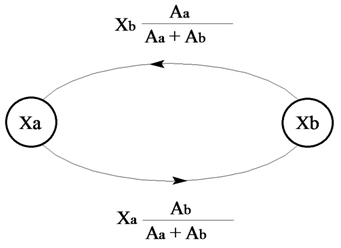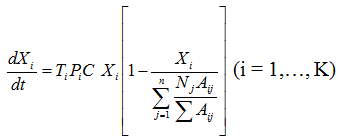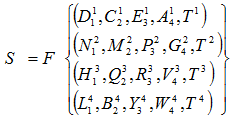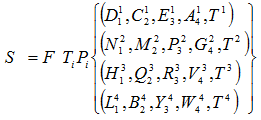КОРРУПЦИЯ ПРИ ФОРМИРОВАНИИ ОПТИМАЛЬНОЙ СТРАТЕГИИ РАЗВИТИЯ ГОРОДСКОЙ СИСТЕМЫ
Тихомирова Е.Г.¹, Семин Е.Г.²
¹ORCID: 0000-0003-4369-8210, Старший преподаватель;
²ORCID: 0000-0001-9330-7711, Доктор технических наук, профессор,
Санкт-Петербургский политехнический университет Петра Великого
КОРРУПЦИЯ ПРИ ФОРМИРОВАНИИ ОПТИМАЛЬНОЙ СТРАТЕГИИ РАЗВИТИЯ ГОРОДСКОЙ СИСТЕМЫ
Аннотация
Рассмотрена проблема коррупции в экологической сфере. Предложено дополнить уравнение Пригожина для выбора из двух одновременно существующих возможностей параметрами, учитывающими уровень знаний и предрасположенность к коррупции лиц, участвующих в принятии решений, в частности, в отношении мероприятий по снижению негативного воздействия на городские экосистемы. Приведены уравнения связи для системы проектирования транспортной инфраструктуры города с учетом параметра коррупции и уровня знаний.
Ключевые слова: коррупция, выбор, уровень знаний, экология, городские системы, транспортная инфраструктура.
Tikhomirova E.G.¹, Semin E.G.²
¹ORCID: 0000-0003-4369-8210, Senior lecturer;
²ORCID: 0000-0001-9330-7711, PhD in Engineering, professor,
Saint-Petersburg Polytechnical University Peter the Great
CORRUPTION IN FORMATION THE OPTIMAL STRATEGY DEVELOPMENT OF URBAN SYSTEM
Abstract
Considered corruption problem in the ecological sphere. Offered addition Prigozhin’s equation for choice from two at the same time existing opportunities by parameters, considering level of knowledge and predisposition to corruption persons, participating in decision-making, in particular, to concerning actions for decrease in negative impact on city ecosystems. Offered communication equation for system of design transport infrastructure of the city taking into account corruption parameter and level of knowledge.
Keywords: corruption, choice, level of knowledge, ecology, urban system, transport infrastructure.
Introduction
Growth cities and strengthening urbanization in the last decades led to increase technogenic impact at all components of urban environment. The main reasons adverse effects of technogenic impact on urban environment is spontaneity in course urbanization and insufficient level of knowledge about difficult natural and technogenic city system [1-3].
The ecological factor should be priority in choice design decisions because unsatisfactory state of environment leads to most serious negative consequences connected with health issues, to ensuring normal activity of population, and survival subsequent generations. At the same time, corruption problem in the ecological sphere is very actual now that is confirmed by data of reports and conferences in this field in Russia and abroad [4].
Subjectivity at realization of choice
Evolution of city system in general (as humanitarian system) and tekhnogenic changed components of urban environment is defined by nature of behavior characters (persons directly related to decision-making in corresponding areas) and conditions imposed by environment. So shown unique specifics of humanitarian systems, consisting in properties of individual person (competence level, level of knowledge, predisposition to corruption, etc.). "Distinction between desirable and valid behavior acts as external condition of new type defining dynamics contours along with environment" [5]. This situation confirms unpredictability of humanitarian systems.
Desirability acceptance concrete i-decision of K alternative opportunities per unit time is proportional to relative attractiveness of i-option. In process of decision-making prize to changing and it reflected as increase or reduction attractiveness of corresponding elections. The loop of feedback is shown in (Fig.) in case of two elections α and β.
![]() represents attractiveness of choice α,
represents attractiveness of choice α, ![]() – number of people, inclined to choice α to real timepoint. Relative number of persons, wishing change own choice on choice β, in proportion to number those who already made other choice α, and relative attractiveness of choice β, defined
– number of people, inclined to choice α to real timepoint. Relative number of persons, wishing change own choice on choice β, in proportion to number those who already made other choice α, and relative attractiveness of choice β, defined ![]() . Similarly number of persons wishing to change choice β on choice α, proportion to
. Similarly number of persons wishing to change choice β on choice α, proportion to ![]() , to multiplied on relative attractiveness α, equal
, to multiplied on relative attractiveness α, equal ![]() .
.

Fig. 1 - The feedback loop, characterizing realization choice on condition two at the same time existing opportunities α and b. Degree of attractiveness opportunities α and b characterize numbers Aα and Ab. The sizes of populations, which made choice α and b, are designated by Xα and Xb respectively [5].
Supposed that population is non-uniform. It breaks up to some various subpopulations Nj, each of which has own idea about relative attractiveness this choice.
Corruption parameter and level of knowledge at decision-making
Prigozhin’s model adopted for formation optimum strategy behavior of system for choice of actions for decrease negative impact on city ecosystems. Offered system of equations balance type (Eq.1).
 |
(1) |
t – time, K – any sample size, Xi – size of population, which made i-behavior option, Aij – attractiveness of i-option for j-population, Nj – subpopulation, having own idea about attractiveness this choice, Pi – weight multiplier, entered for analysis effects, connected with lobbying in decision-making. Size Pi strongly depends from Xi and with increase size of population Xi sharply falls, Ti – weight multiplier, entered for accounting level of knowledge (competence) persons, making this or that decision.
The analysis of system nonlinear differential equations shows possibility of occurrence several branches decisions with difficult set of bifurcation phenomena. The system is instability to fluctuations in initial conditions in case small values Xi. This connected with strong nonlinearity dependence Pi from Xi. Lobbying decisions most probably at earliest stage formation population, accepting i-behavior option. Possible to operate process of lobbying by variation initial values Xi or by reduction humanitarian influence on parameter Pi. The first option to decrease of protectionism in decision-making is democratization of decisions. The second option provides to increase role of objective factors in choice this or that decision. In case when Pi = const, system of equations remains nonlinear and possibility existence several branches of decision remains, though effects lobbying decisions disappear.
(Eq.1) can be used for assessment technologies, applied in municipal economy, technologies processing building and solid municipal waste, etc. [6-8]. This formula defines objectivity any tender commission.
Formation rational transport infrastructure of the city taking into account parameter of corruption and level of knowledge
Considered, as example, system of design transport infrastructure, which is a part of city system. This system possible to present in form a matrix.
The system of design transport infrastructure [9-11] includes following subsystems: constructive and technical, organizational and administrative, planning and urban development, environment protection.
The condition of each subsystems can be estimated as follows
| |
(2) |
![]() – condition of j-subsystems;
– condition of j-subsystems;
![]() – influencing i-factor j-subsystems;
– influencing i-factor j-subsystems;
![]() – time period of i-factor;
– time period of i-factor;
i = 1, …, n; j = 1, 2, 3, 4.
The constructive and technical subsystem (![]() ) includes actions for high-quality diagnostics and car repairs (
) includes actions for high-quality diagnostics and car repairs (![]() ), introduction catalytic neutralizers (
), introduction catalytic neutralizers (![]() ), development and deployment eco-friendly means of transport (ecobuses, ecomobiles) (
), development and deployment eco-friendly means of transport (ecobuses, ecomobiles) (![]() ), implementation program of phased transition transport on alternative types fuel (
), implementation program of phased transition transport on alternative types fuel (![]() ).
).
The organizational and administrative subsystem (![]() ) includes development normative legal acts in the field of environmental protection (
) includes development normative legal acts in the field of environmental protection (![]() ), improvement organization movement of transport streams (
), improvement organization movement of transport streams (![]() ), creation priority public transport (
), creation priority public transport (![]() ), development system penalties for operation technically faulty transport (
), development system penalties for operation technically faulty transport (![]() ).
).
The planning and urban development subsystem (![]() ) includes design and construction high-speed highways (
) includes design and construction high-speed highways (![]() ), construction bypass highways for unloading downtown (
), construction bypass highways for unloading downtown (![]() ), organization works on improvement roadside territories (
), organization works on improvement roadside territories (![]() ), construction underground crosswalks for increase bandwidth of streets (
), construction underground crosswalks for increase bandwidth of streets (![]() ).
).
The environmental protection subsystem (![]() ) includes gardening territory, use land relief (
) includes gardening territory, use land relief (![]() ), rational choice of types buildings coming to highways (
), rational choice of types buildings coming to highways (![]() ), use protective designs (acoustic cranes, natural protective designs, etc.) (
), use protective designs (acoustic cranes, natural protective designs, etc.) (![]() ), application effective ways of planning quarters (
), application effective ways of planning quarters (![]() ).
).
Thus, system of design transport infrastructure can be described by following communication equation
 |
(3) |
(Eq. 3) can be added with weight multipliers Pi and Ti, considering corruption parameter and level of knowledge, necessary for formation rational transport infrastructure.
Thus, turns out following system of equations
 |
(4) |
Similarly possible to write down equations for system of address with solid municipal waste, for system of ensuring quality water supply, for system of gardening of the city, etc.
Список литературы / References
- Тихомирова Е.Г., Семин Е.Г. Обеспечение экологической безопасности в условиях большого города // Вестник Российского университета дружбы народов, серия «Экология и безопасность жизнедеятельности». – 2010. – № 1. – С. 82-87.
- Тихомирова Е.Г. Оптимизация состояния техногенно-измененных экосистем большого города как фактор безопасности геоэкологической среды // Экология и промышленность России. – 2013. – № 6. – С. 56-60.
- Тихомирова Е.Г., Семин Е.Г. Концепция устойчивого строительства в рамках экологии // ПРОМТЕКС. – 2008. – № 2 [3]. – С. 26-27.
- Тихомирова Е.Г. Роль субъективного человеческого фактора в процессе принятия решений в области экологии // Материалы IV международной научно-практической конференции «Современные концепции научных исследований». Ч. 6. № 4. М.: Изд-во ЕСУ. – 2014. – С. 64-67.
- Николис Г., Пригожин И. Познание сложного. – М.: Мир, 1990. – 344 с.
- Тихомирова Е.Г. Альтернатива мусоросжиганию // Экология и жизнь. – 2010. – № 4 (101). – С. 30-33.
- Тихомирова Е.Г. Комплексная переработка твердых коммунальных отходов – стабилизирующий фактор в рамках геоэкологии // Безопасность жизнедеятельности. – 2013. – № 7. – С. 19-24.
- Тихомирова Е.Г., Семин Е.Г. Экологические принципы обращения с твердыми бытовыми отходами // Жизнь и Безопасность. – 2007. – № 3-4. – С. 120-124.
- Тихомирова Е.Г., Зенцов В.Н., Семин Е.Г. Экологосистемный подход к проектированию городской транспортной инфраструктуры // Системный анализ в проектировании и управлении: Труды XI Международной научно-практической конференции. Ч.2. СПб.: Изд-во Политехнического университета. – 2007. – С. 139-142.
- Зенцов В.Н., Тихомирова Е.Г., Семин Е.Г. Многоаспектная сложность формирования транспортной инфраструктуры крупных городов // ПРОМТЕКС. – – № 2 [3]. – С. 24-25.
- Тихомирова Е.Г., Зенцов В.Н., Семин Е.Г. Интегральная оценка риска здоровью от объектов транспортной инфраструктуры // Научно-технические ведомости СПбГПУ. СПб.: Изд-во Политехнического университета. – 2009. – № 2 (78). – С. 185-192.
Список литературы на английском языке / References in English
- Tikhomirova E.G., Semin E.G. Obespechenie jekologicheskoj bezopasnosti v uslovijah bol'shogo goroda [Maintenance of ecological safety in the conditions of the city] // Vestnik Rossijskogo universiteta druzhby narodov [Bulletin of Russian Peoples' Friendship University]. – 2010. – № 1. – P. 82-87. [in Russian]
- Tikhomirova E.G. Optimizacija sostojanija tehnogenno-izmenennyh jekosistem bol'shogo goroda kak faktor bezopasnosti geojekologicheskoj sredy [Optimization of man-caused altered ecosystems state of big city as factor of geo-ecological terrain`s safety] // Jekologija i promyshlennost' Rossii [Ecology and Industry of Russia]. – 2013. – №. 6. – P. 56-60. [in Russian]
- Tikhomirova E.G., Semin E.G. Koncepcija ustojchivogo stroitel'stva v ramkah jekologii [Concept sustainable development in framework of ecology] // – 2008. – № 2 (3). – P. 26-27. [in Russian]
- Tikhomirova E.G. Rol' subektivnogo chelovecheskogo faktora v processe prinjatija reshenij v oblasti jekologii [Role subjective human factor in decision-making process in the field of ecology] // Materialy IV mezhdunarodnoj nauchno-prakticheskoj konferencii «Sovremennye koncepcii nauchnyh issledovanij» [Proc. IV International Scientific and Practical Conference "Modern Concepts of Scientific Researches"]. – 2014. – № 4 (6). – P. 64-67. [in Russian]
- Nikolis G., Prigozhin I. Exploring Complexity. – Publ. World, 1990. – 344 p.
- Tikhomirova E.G. Al'ternativa musoroszhiganiju [The alternative to incineration] // Jekologija i zhizn' [Ecology and Life]. – 2010. – № 4 (101). – P. 30-33. [in Russian]
- Tikhomirova E.G. Kompleksnaja pererabotka tverdyh kommunal'nyh othodov – stabilizirujushhij faktor v ramkah geojekologii [Complex processing of solid municipal waste – stabilising factor in the framework of geoecology] // Bezopasnost' zhiznedejatel'nosti [Health and Safety]. – 2013. – № 7. – P. 19-24. [in Russian]
- Tikhomirova E.G., Semin E.G. Jekologicheskie principy obrashhenija s tverdymi bytovymi othodami [Ecological principles for treatment of solid waste] // Zhizn' i Bezopasnost' [Life and Safety]. – 2007. – № 3-4. – P. 120-124. [in Russian]
- Tikhomirova E.G., Zentsov V.N., Semin E.G. Jekologosistemnyj podhod k proektirovaniju gorodskoj transportnoj infrastruktury [Ecological approach to design of urban transport infrastructure] // Sistemnyj analiz v proektirovanii i upravlenii: Trudy XI Mezhdunarodnoj nauchno-prakticheskoj konferencii [Proc. XI International Scientific and Practical Conference "System analysis in designing and management"]. – 2007. – P. 139-142. [in Russian]
- Zentsov V.N., Tikhomirova E.G., Semin E.G. Mnogoaspektnaja slozhnost' formirovanija transportnoj infrastruktury krupnyh gorodov [Multifaceted complexity formation of transport infrastructure of big cities] // – 2008. – № 2 (3). – P. 24-25. [in Russian]
- Tikhomirova E.G., Zentsov V.N., Semin E.G. Integral'naja ocenka riska zdorov'ju ot obektov transportnoj infrastruktury [Integrated health risk assessment of transport infrastructure] // Nauchno-tehnicheskie vedomosti SPbGPU [Scientific and technical statements SPbGPU]. – 2009. – № 2 (78). – P. 185-192. [in Russian]
